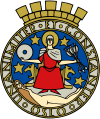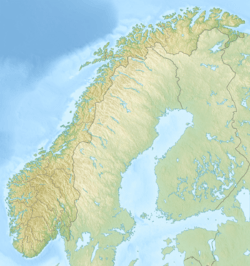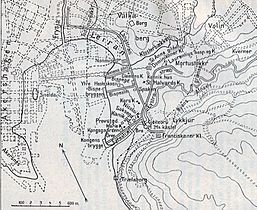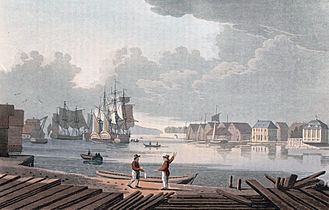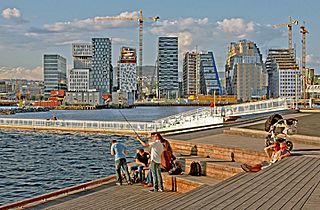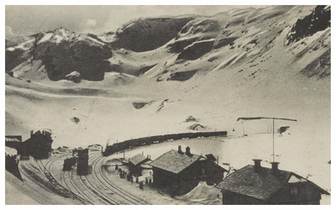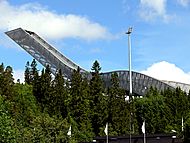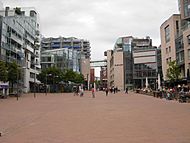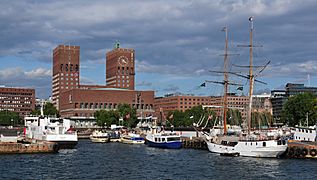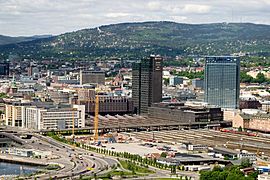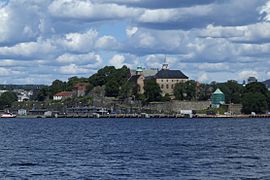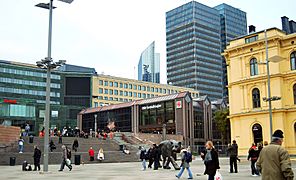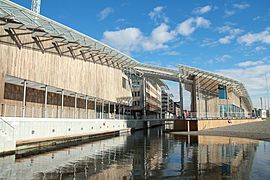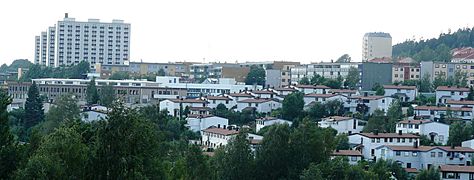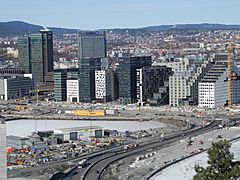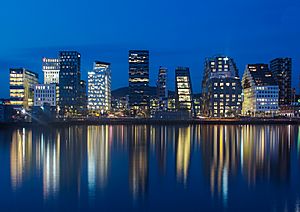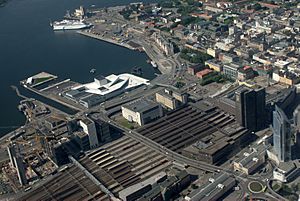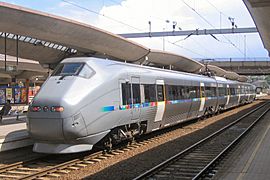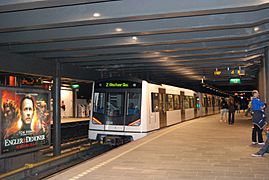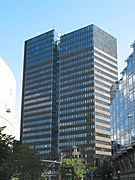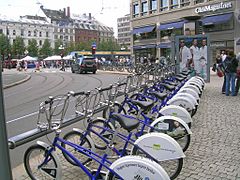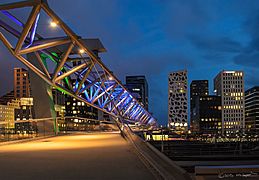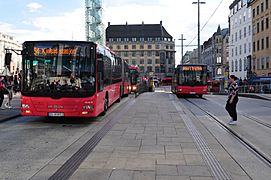Oslo facts for kids
Quick facts for kids
Oslo
|
|||
|---|---|---|---|
|
Capital city, county and municipality
|
|||
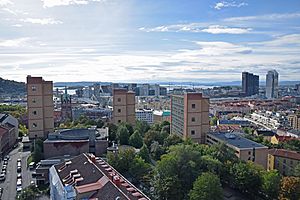 |
|||
|
|||
| Motto(s):
Unanimiter et constanter (Latin)
"United and constant" |
|||
| Country | Norway | ||
| District | Østlandet | ||
| County | Oslo | ||
| Established | 1048 | ||
| Area | |||
| • Capital city, county and municipality | 480.76 km2 (185.62 sq mi) | ||
| • Land | 454.08 km2 (175.32 sq mi) | ||
| • Water | 26.68 km2 (10.30 sq mi) | ||
| Elevation | 23 m (75 ft) | ||
| Population
(1 January 2018)
|
|||
| • Capital city, county and municipality | 673,469 | ||
| • Density | 1,400.842/km2 (3,628.17/sq mi) | ||
| • Urban | 1,000,467 | ||
| • Metro | 1,588,457 | ||
| Time zone | UTC+1 (CET) | ||
| • Summer (DST) | UTC+2 (CEST) | ||
| Postal code |
0001 – 1299
|
||
| Area code(s) | (+47) 00 | ||
| HDI (2017) | 0.968 very high |
||
|
Oslo kommune
|
||
|---|---|---|
|
Municipality
|
||
|
||
| Country | Norway | |
| County | Oslo | |
| Time zone | UTC+01:00 (CET) | |
| • Summer (DST) | UTC+02:00 (CEST) | |
| ISO 3166 code | NO-0301 | |
| Official language form | Neutral | |
|
|
||
Oslo is the capital city of Norway. It is Norway's largest city, with a population of 647,676 people in 2015. The area near the city has a total population of 1,546,706. The city government of Oslo and the county are the same thing.
Contents
History
The Saga of Norwegian Kings (written by Snorre Sturlason) says that king Harald III Sigurdsson founded Oslo around 1048. Recent archaeological research has found Christian graves from before 1000. Because of these two facts, Oslo celebrated its 900 year anniversary in 1950 and its 1000 year anniversary in 2000.
One of the more famous landmarks in Oslo is Akershus Fortress. It was first built around 1290. Oslo was destroyed in fire in 1624, and the fortress was rebuilt closer to Akershus Fortress by the order of King Christian IV of Norway. The king gave the new city the name Christiania, which later also written as Kristiania. In 1925 the name of the city was changed back to Oslo.
Oslo today
The city is an economic and cultural epicenter. Many important institutions are in Oslo. Among these are the Norwegian government and parliament, the University of Oslo and Ullevål Stadium, the stadium of Norway's soccer team. The city also has many museums, theaters and concert venues. Some good cultural places are Frognerparken, the Oslo Opera, the National Museum and the National Theatre. Travelling inside the city is easy with public transportation. Using tram, subway and bus is easy.
-
Port of Christiania c. 1800
by John William Edy -
Railway between Christiania and Bergen, 1916.
Geography
Oslo occupies an arc of land at the northernmost end of the Oslofjord. The fjord, which is nearly bisected by the Nesodden peninsula opposite Oslo, lies to the south; in all other directions Oslo is surrounded by green hills and mountains. There are 40 islands within the city limits, the largest being Malmøya (0.56 km2 or 0.22 sq mi), and scores more around the Oslofjord. Oslo has 343 lakes, the largest being Maridalsvannet (3.91 km2 or 1.51 sq mi). This is also a main source of drinking water for large parts of Oslo.
Although Eastern Norway has a number of rivers, none of these flow into the ocean at Oslo. Instead Oslo has two smaller rivers: Akerselva (draining Maridalsvannet, which flows into the fjord in Bjørvika), and Alna. The waterfalls in Akerselva gave power to some of the first modern industry of Norway in the 1840s. Later in the century, the river became the symbol of the stable and consistent economic and social divide of the city into an East End and a West End; the labourers' neighbourhoods lie on both sides of the river, and the divide in reality follows Uelands street a bit further west. River Alna flows through Groruddalen, Oslo's major suburb and industrial area. The highest point is Kirkeberget, at 629 metres (2,064 ft). Although the city's population is small compared to most European capitals, it occupies an unusually large land area, of which two-thirds are protected areas of forests, hills and lakes. Its boundaries encompass many parks and open areas, giving it an airy and green appearance.
Cityscape
Oslo's cityscape is being redeveloped as a modern city with various access-points, an extensive metro-system with a new financial district and a cultural city. In 2008, an exhibition was held in London presenting the award-winning Oslo Opera House, the urban regeneration scheme of Oslo's seafront, Munch/Stenersen and the new Deichman Library. Most of the buildings in the city and in neighbouring communities are low in height with only the Plaza, Posthuset and the highrises at Bjørvika considerably taller.
Architecture
Oslo's architecture is very diverse. The architect Carl Frederik Stanley (1769–1805), who was educated in Copenhagen, spent some years in Norway around the turn of the 19th century. He did minor works for wealthy patrons in and around Oslo, but his major achievement was the renovation of the Oslo Katedralskole, completed in 1800. He added a classical portico to the front of an older structure, and a semicircular auditorium that was sequestered by Parliament in 1814 as a temporary place to assemble, now preserved at Norsk Folkemuseum as a national monument.
When Christiania was made capital of Norway in 1814, there were practically no buildings suitable for the many new government institutions. An ambitious building program was initiated, but realised very slowly because of economic constraints. The first major undertaking was the Royal Palace, designed by Hans Linstow and built between 1824 and 1848. Linstow also planned Karl Johans gate, the avenue connecting the Palace and the city, with a monumental square halfway to be surrounded by buildings for University, the Parliament (Storting) and other institutions. Only the university buildings were realised according to this plan. Christian Heinrich Grosch, one of the first architects educated completely within Norway, designed the original building for the Oslo Stock Exchange (1826–1828), the local branch of the Bank of Norway (1828), Christiania Theatre (1836–1837), and the first campus for the University of Oslo (1841–1856). For the university buildings, he sought the assistance of the renowned German architect Karl Friedrich Schinkel. German architectural influence persisted in Norway, and many wooden buildings followed the principles of Neoclassicism. In Oslo, the German architect Alexis de Chateauneuf designed Trefoldighetskirken, the first neo-gothic church, completed by von Hanno in 1858.
A number of landmark buildings, particularly in Oslo, were built in the Functionalist style (better known in the US and Britain as Modernist), the first being Skansen restaurant (1925–1927) by Lars Backer, demolished in 1970. Backer also designed the restaurant at Ekeberg, which opened in 1929. Kunstnernes Hus art gallery by Gudolf Blakstad and Herman Munthe-Kaas (1930) still shows the influence of the preceding classicist trend of the 1920s. The redevelopment of Oslo Airport (by the Aviaplan consortium) at Gardermoen, which opened in 1998, was Norway's largest construction project to date.
Economy
Oslo has a varied and strong economy and was ranked number one among European large cities in economic potential in the fDi Magazine report European Cities of the Future 2012. It was ranked 2nd in the category of business friendliness, behind Amsterdam.
Oslo is an important centre of maritime knowledge in Europe and is home to approximately 1980 companies and 8,500 employees within the maritime sector. Some of them are the world's largest shipping companies, shipbrokers, and insurance brokers. The city's port is the largest general cargo port in the country and its leading passenger gateway. Close to 6,000 ships dock at the Port of Oslo annually with a total of 6 million tonnes of cargo and over five million passengers.
The GDP of Oslo totalled €64 billion(€96,000 per capita) in 2016, which amounted to 20% of the national GDP. This compares with NOK166 billion (US$17 billion) in 1995. The metropolitan area, bar Moss and Drammen, contributed 25% of the national GDP in 2003 and was also responsible for more than one quarter of tax revenues. In comparison, total tax revenues from the oil and gas industry on the Norwegian Continental Shelf amounted to about 16%.
Oslo is one of the most expensive cities in the world. As of 2006[update], it is ranked tenth according to the Worldwide Cost of Living Survey provided by Mercer Human Resource Consulting and first according to the Economist Intelligence Unit. The reason for this discrepancy is that the EIU omits certain factors from its final index calculation, most notably housing. In the 2015 update of the EIU’s Worldwide Cost of Living survey, Oslo now ranks as the third most expensive city in the world. Although Oslo does have the most expensive housing market in Norway, it is comparably cheaper than other cities on the list in that regard. Meanwhile, prices on goods and services remain some of the highest of any city. Oslo hosts 2654 of the largest companies in Norway. Within the ranking of Europe's largest cities ordered by their number of companies Oslo is in fifth position. A whole group of oil and gas companies is situated in Oslo.
According to a report compiled by Swiss bank UBS in the month of August 2006, Oslo and London were the world's most expensive cities.
Environment
Oslo is a compact city. It is easy to move around by public transportation and rentable city bikes are accessible to all, all over the city centre. In 2003, Oslo received The European Sustainable City Award and in 2007 Reader's Digest ranked Oslo as number two on a list of the world's greenest, most liveable cities.
Culture
Oslo has a large and varied number of cultural attractions, which include several buildings containing artwork from Edvard Munch and various other international artists but also several Norwegian artists. Several world-famous writers have either lived or been born in Oslo. Examples are Knut Hamsun and Henrik Ibsen. The government has recently invested large amounts of money in cultural installations, facilities, buildings and festivals in the City of Oslo. Bygdøy, outside the city centre is the centre for history and the Norwegian Vikings' history. The area contains a large number of parks and seasites and many museums. Examples are the Fram Museum, Vikingskiphuset and the Kon-Tiki Museum. Oslo hosts the annual Oslo Freedom Forum, a conference described by The Economist as "on its way to becoming a human-rights equivalent of the Davos economic forum." Oslo is also known for giving out the Nobel Peace Prize every year.
Food
Grønland, the central areas around Youngstorget and Torggata, Karl Johans gate (the main pedestrian thoroughfare), Aker Brygge and Tjuvholmen, Sørenga, and the boroughs of Frogner, Majorstuen, St. Hanshaugen / Bislett, and Grünerløkka all have a high concentration of cafes and restaurants. There are several food markets, the largest being Mathallen Food Hall at Vulkan with more than 30 specialty shops, cafés, and eateries.
As of March 2018 six Oslo restaurants were mentioned in the Michelin Guide. Maaemo is the only Norwegian restaurant ever to have been awarded three Michelin stars. Statholdergaarden, Kontrast, and Galt each have one star. Only two restaurants in Oslo have a BIB gourmand mention: Restaurant Eik and Smalhans.
Transport
| Airports around Oslo | Airport | IATA/ICAO | Passengers (2013) |
|---|---|---|---|
 |
Gardermoen | OSL/ENGM | 22,956,540 |
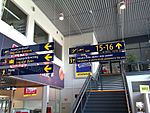 |
Torp | TRF/ENTO | 1,856,897 |
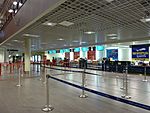 |
Rygge (closed 2016) |
RYG/ENRY | 1,849,294 |
Oslo has Norway's most extensive public transport system, managed by Ruter. This includes the six-line Oslo Metro, the world's most extensive metro per resident, the six-line Oslo Tramway and the eight-line Oslo Commuter Rail. The tramway operates within the areas close to the city centre, while the metro, which runs underground through the city centre, operates to suburbs further away; this includes two lines that operate to Bærum, and the Ring Line which loops to areas north of the centre. Oslo is also covered by a bus network consisting of 32 city lines, as well as regional buses to the neighboring county of Akershus.
Oslo Central Station acts as the central hub, and offers rail services to most major cities in southern Norway as well as Stockholm and Gothenburg in Sweden. The Airport Express Train operates along the high-speed Gardermoen Line. The Drammen Line runs under the city centre in the Oslo Tunnel. Some of the city islands and the neighbouring municipality of Nesodden are connected by ferry. Daily cruiseferry services operate to Copenhagen and Frederikshavn in Denmark, and to Kiel in Germany.
Many of the motorways pass through the downtown and other parts of the city in tunnels. The construction of the roads is partially supported through a toll ring. The major motorways through Oslo are European Route E6 and E18. There are three beltways, the innermost which are streets and the outermost, Ring 3 which is an expressway.
The main airport serving the city is Gardermoen Airport, located in Ullensaker, 47 kilometres (29 mi) from the city centre of Oslo. It acts as the main international gateway to Norway, and is the sixth-largest domestic airport in Europe. Gardermoen is a hub for Scandinavian Airlines, Norwegian Air Shuttle and Widerøe. Oslo is also served by a secondary airport, which serve some low-cost carriers, such as Ryanair: Torp Airport, 110 kilometres (68 mi) from the city.
-
Flytoget – the Airport Express Train – a high-speed rail service connecting the city with its main airport at Gardermoen
Images for kids
-
The National Theatre is the largest theatre in Norway
-
Bislett Stadium during a friendly between Lyn Oslo and Liverpool F.C.
-
Gro Harlem Brundtland, 2010
-
Jens Stoltenberg, 2019
-
Henrik Ibsen, 1895
-
Edvard Munch, 1933
-
1800s-1900s: The University of Kristiania
See also
 In Spanish: Oslo para niños
In Spanish: Oslo para niños



